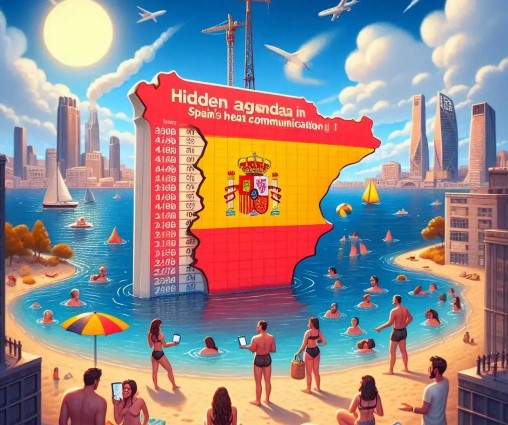Ministry of Health publishes controversial “Guide to Health and Heat Communication SUMMER 2025“
The Spanish government under Pedro Sánchez is facing criticism after its latest publication, the “Guide to Health and Heat Communication SUMMER 2025,” was found to instruct on dramatizing the issue of heat rather than providing preventive measures. This guide, aimed at journalists, healthcare professionals, and communicators, suggests that heat kills, and selectively uses alarming data while ignoring historical trends and relying on emotional rather than fact-based persuasion.
Manipulated Figures: Focusing Only on the Worst Years
According to critics, the document exclusively focuses on the years 2022 and 2023, which saw the highest heat-related deaths since 2015, with 4,744 and 3,009 fatalities respectively. However, it deliberately omits the average figures from 2015 to 2021 (1,989 deaths per summer) and the decline in deaths in 2024 and 2025 (2,012 and 337 by the end of June). This selective data usage raises questions about whether a political agenda is being pursued rather than a comprehensive approach to informing about health risks.
Ideology Over Science: Climate Change as a Communication Weapon?
Another critical point of the guide is the direct link it makes between heat and climate change. It recommends strengthening this narrative, as “belief in climate change favors adaptive behaviors.” The issue becomes more controversial when the guide adapts messages to ideological profiles: According to CIS surveys, only 60 percent of people who identify with the right believe that climate change is a threat, compared to 95 percent of those on the left. This raises the alarming question of whether public health campaigns are being subordinated to political discourse.
Emotional Conditioning: No Beaches, Only Hospitals
The guide even goes so far as to avoid pleasant images associated with heat. Instead, “negative images are recommended that link heat to health risks or bad times.” The goal is emotional conditioning of the public to create discomfort and reinforce the seriousness of the message. Heat should no longer be perceived as a summer phenomenon but as a “visible threat.”
The Vague Concept of “Heat Culture”
The introduction of the term “heat culture” and the claim that 28 °C in Galicia could be worse than 37 °C in Andalusia lack any concrete data, according to critics. While the idea of climate adaptation may have a basis, the guide lacks clinical thresholds, comparisons between communities, or epidemiological studies. It remains a vague concept that mixes various factors without clear distinction.
Communication or Propaganda?
The guide, according to critics, is not a technical document for public health, but an ideological communication guide. By omitting key data, avoiding scientific plurality, and resorting to emotional conditioning, it ceases to be a health tool and becomes a political instrument. The strategy appears to aim at manipulating perceived risk rather than communicating actual risk comprehensively and evidence-based.




